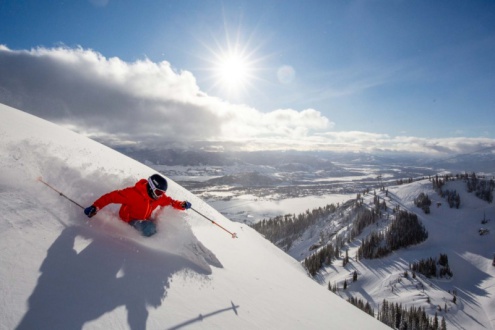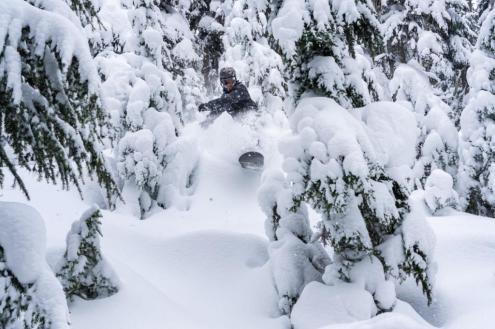Who got the most snow in North America in 2019-20?
Guest feature by Tony Crocker, 25 September 2020
2019-20 was a moderately below average snowfall season in North America's ski areas, at 94% of normal. The only conspicuously deficient region over the festive holiday season was the Pacific Northwest, but it was then hammered with snow in January.
Ski area visitation was overall strong and comparable to 2018-19, until the abrupt shutdown of resorts in mid-March due to Covid-19. Nearly all areas closed on 14/15 March 2020, so 16% of skier visits were lost compared to 2018-19.
A handful of areas reopened in late spring, all of which required advance reservation of limited tickets, the wearing of masks and compliance with social distancing measures.
California
California was dry through most of November but got 1.5m during the last week of the month. After two more storms brought another 1.5m of snowfall before Christmas, the holiday season was above average, but January was below average with destructive winds. February was then the driest on record, with no more than 10cm falling in the entire month.
The largest storm of the season, bringing 1.5-2m, began on 15 March 2020 when all major areas had closed due to Covid-19. Three small ski areas remained open until 19-20 March 2020.
Easter week saw more than 1m of snowfall, though by this point the only area that opened in North America was Mt. Baldy (from 22 April to 3 May 2020).
Overall, California's season saw 86% of its average snowfall due to the dry mid-winter period. Heavenly’s upper site got 7.0m (71%) and Kirkwood 8.5m (73%). Squaw Valley's upper site (10.2m, 85%) led the region while Mammoth got 7.1m (79%).
Utah
Utah also got off to a good start, with 1.5m in late November and 1m+ more before Christmas. More snow fell over the holidays and January was continuously snowy, totaling 2-3m+. The rest of the season was below average though, except for a 1m+ storm in late March.
Overall the season was 99% of normal, but it had been much better than that before the resorts closed (by 15 March 2020). Alta led the state with 12.8m (97%), while Park City got 8.5m (115%), Snowbasin 7.7m (95%) and Snowbird 10.4m (82%).
The Northeast
The Northeast had 88% of its normal snowfall overall, and a qualitatively mediocre season. Snowfall was below average through mid-January and the region was plagued with repeated rain and thaw, although skiing improved later in the month with a metre of snow.
February was the stand-out month, with 1-2m of snow and cold temperatures. Warm weather and rain then returned in March, so conditions were deteriorating when skiing shut down mid-month. Most of the spring remained warm, though there was a freak snowstorm in early May.
Smuggler's Notch had 6.6m (92%), while Sugarbush had 5.0m (73%), Killington 4.8m (78%) and Sugarloaf 4.3m (98%). Due to the early closure of resorts due to Covid-19, data for many other resorts in the Northeast is incomplete.
US Northern Rockies
The U.S. Northern Rockies had 93% of normal snowfall overall, with November/December being below average and particularly lean near the Canadian border. The region was then hammered with 2-3m in January and another 1.5m in early February. The rest of the season was below average.
Ski areas in this region stayed open longer than elsewhere in in the U.S. in March, four staying open until at least 20 March 2020, with Lookout Pass remaining open until 25 March 2020. The Beartooth Basin summer ski area was also open for its usual 30 May to mid-June season.
Grand Targhee led the region with 11.0m (93%), while Jackson Hole had 10.4m (111%) and Big Sky 8.8m (120%). Whitefish (7.0m, 84%) and Schweitzer (6.4m, 88%) did not fare as well due to their slower start.
Interior Western Canada
Interior Western Canada had average November snowfall to the north, but was very dry near the U.S. border. However, 1.5-2m of December snow led to a good holiday season in most areas.
The Banff areas had a normal January but the rest of the region got double their normal snowfall, with an average of 3m. February and March were average, while April was below average. Despite this, Interior Western Canada was the strongest region in North America for 2019-20, with 112% of its average snowfall.
Ski areas in the region were closed by provincial governments on 16/17 March 2020 and none reopened. Whitewater led the region with 10.5m (105%), while Big White had 8.2m (113%), Fernie 8.5m (90%) and Lake Louise 6.3m (143%).
Colorado (and New Mexico)
Colorado's Front Range/I-70 resorts had a below average November but recovered enough in December to have an average holiday season. January was also average, but February was a big month with 1.5-2.5m of snow.
March and early April were below average, but it snowed over a metre in late April, concluding the season at 95% of normal, long after all areas had closed by the Colorado governor’s order on 14 March 2020. Ski Apache in New Mexico remained open until 22 March 2020.
The Southwest had a strong early season, with three storms averaging close to a metre each from late November through the holidays. The ensuing months were below average, though, with April being very dry, so the Southwest finished at 90% of normal. Wolf Creek had 8.4m (85%), while Aspen Snowmass had 6.8m (93%) and Taos 6.2m (96%). Breckenridge had 9.6m (107%), Winter Park 9.1m (103%) and Vail 8.2m (91%).
A-Basin (6.7m, 85%) reopened from 27 May to 7 June 2020, limited to 600 skiers per day selected by lottery.
Pacific Northwest
The Pacific Northwest had its driest November on record leading to Whistler, despite December being only moderately below average, having its lowest ever percentage of slopes (30%) open at Christmas. This situation was quickly rectified by 4-5 metres in January.
February and March were below average and April was quite dry, resulting in the region having 87% of its average snowfall for the season overall.
Mt. Baker led both the Pacific Northwest and North America with 16.2m (103%) including 7.5m in January. Whistler had 9.7m (91%), Crystal 8.5m (81%) and Mt. Hood 9.6m (84%).
After all areas closed in mid-March, Mt. Bachelor did later reopen to season passholders from 16-24 May 2020. Crystal also reopened from 1-7 June 2020 and Timberline opened for summer on 15 May 2020.
Tony Crocker is an award-winning snow-sports journalist
and founder of www.bestsnow.net - the definitive guide to weather
and snowfall patterns in North American Ski resorts.
Read more about him here
See who got the most snow in North America in other years










